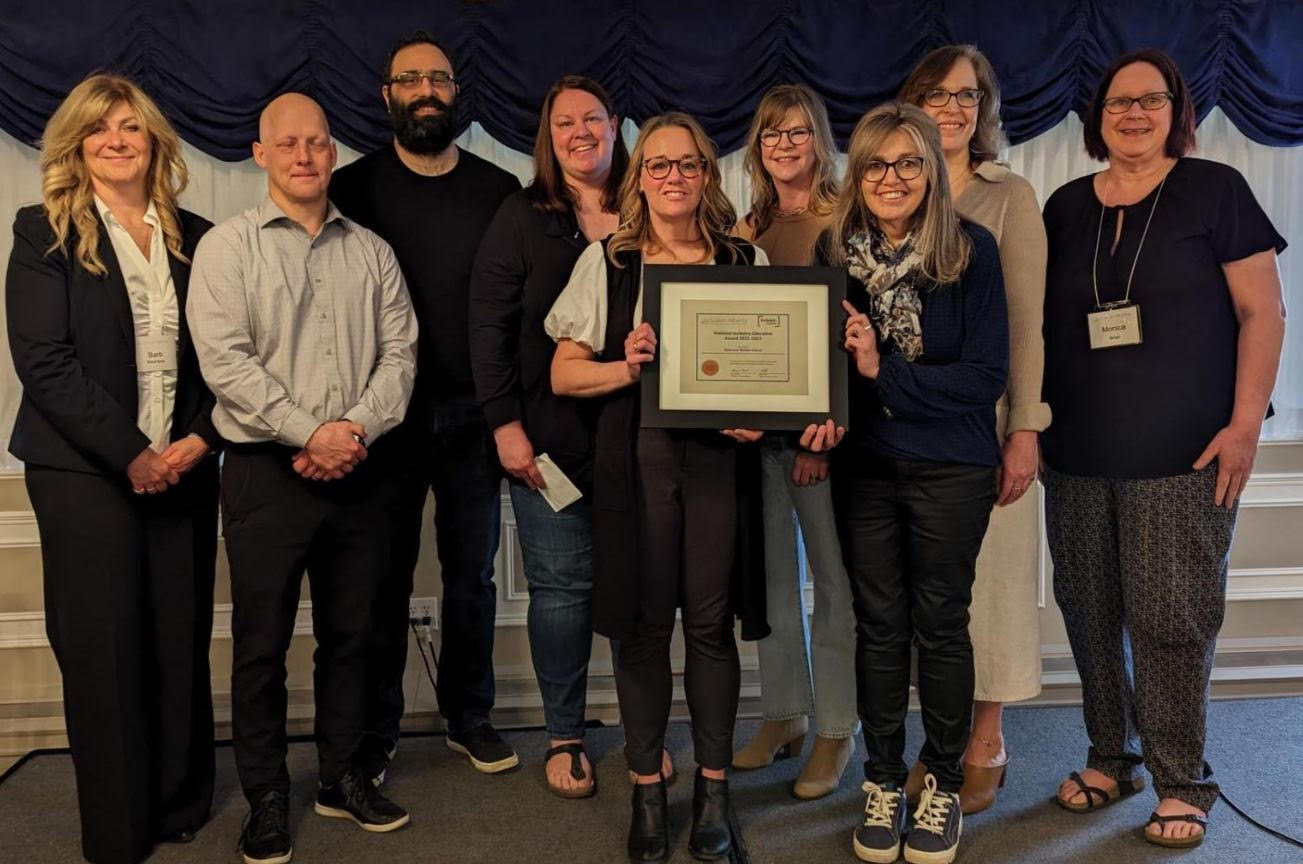Red Deer Public staff honoured with National Inclusive Education Award
One of Red Deer Public’s priorities is equity and ensuring fairness for all students through excellence in instruction, support for students, and reduction of barriers. As a result of this dedication, staff at Eastview Middle School, as well as a long-time Learning Assistance Teacher at Hunting Hills High School have been honoured with a national award for their commitment to inclusion of all students.
The nomination for Eastview Middle School named Teachers Hanna Delmont and Isaac Terrenzio, Learning Assistance Teacher Lynn Lawton-Paquin and Educational Assistants Jen Gouldie and Barb Yost. Hunting Hills Teacher Lesley Young was also a recipient.
The National Inclusive Education Award for Alberta is provided jointly by Inclusion Canada and Inclusion Alberta to honour a teacher, school or school division whose commitment to inclusive education is exemplary and deserving of recognition.
Lesley, who has worked in Red Deer Public Schools for 28 years, was nominated by a parent of a student at the school, and said she feels honoured to be a recipient of the prestigious award.

“I was shocked and humbled,” she said. “Our school operates under the idea of collective responsibility, so all of the students are the responsibility of all of the adults in the school. I am just a small part of the day of that particular student. I asked this student to be the manager of my rugby team, and he came out in a managerial role all of last year and was involved in every practice, every game and every team bonding activity. I have felt strongly about inclusion at our school and have worked hard to support that initiative in our school. I want all students to have access to the array of amazing opportunities offered at our school.”
Darwin Roscoe, Principal at Hunting Hills, said Lesley is deserving of the recognition.
“Lesley has been a massive contributor to student success throughout the duration of her career,” he said. “Her child-centered approach has always been front and centre of her practice.
Her work with inclusion spans well beyond students and their families and deep into our teacher’s pedagogy at the school.”
Kevin Robertson, who was Principal at Eastview at the time of the nomination, said he is proud of the entire school team. Eastview was also nominated by a parent of a student at the school.
“’It takes a village’ certainly rings true, and in this case, I am so proud of the work the school team has done and continues to do in partnership with parents. It really is a whole-team success,” he said.
Hanna said as a fifth year teacher, she has had the privilege of working with a variety of diverse students.
“When we received this award, I was extremely proud of the collaborative connection that Eastview staff takes to help meet students’ needs,” she said. “Providing a safe, caring and inclusive school environment allows all students and families to have a sense of belonging where each member can flourish in their own way.”
Isaac added receiving a national award in inclusive education is a tremendous honour.
“Being recognized for the dedication and hard work our staff puts toward ensuring that all learners, regardless of their abilities or backgrounds, have equal access to education and are supported to reach their full potential is very humbling,” he said. “Continuing to strive towards equity and inclusion in education is important in creating a welcoming learning environment for all.”
Lynn said she feels Eastview Middle, like so many others in Red Deer Public, supports all students with their academic, personal and social needs.
“I am proud to work in a school with talented, hard working and caring staff that go above and beyond to ensure that our most complex students are having a positive experience at school that includes learning curriculum, developing meaningful relationships and building skills to develop independence,” she said.
Barb added she was thrilled to hear of the award as Eastview is very deserving.
“Students with special needs should have the opportunity to learn, play and make friends with their peers,” she said, of why inclusion is important. “The whole school benefits and learns from having all students included.”
Jen, who said she feels overwhelmed with emotion after receiving the award, agreed.
“Inclusive education is important because of the moments of empathy, compassion and acceptance that our students are able to witness and be a part of everyday. It is when a student needs to draw to get their story out of their head. Then randomly, a fellow student sits down beside them and word by word, marker by marker, draws out the story. It is when a student reaches out to another student for a hug and the embrace is accepted. It is when a student is curious about what is happening in the classroom next door then they are warmly welcomed with a ‘hello!’” she said. “These types of inclusive moments impact how students view and experience the world as they walk through their lives.”
Darrin DeMale, Principal at Eastview, gives credit to his whole school team. “We have some incredibly special adults that love being with our students on a daily basis. We feel fortunate to have a group of individuals that value their presence at Eastview and value being with them and growing life skills.”
Sue Merry, Vice Principal at Eastview, added it is an honour to receive this award as a whole team. “We see this award as recognition of how our school values inclusion in the forefront of the work we are doing with our students,” she said. “It generally reflects the work of everyone at the school from our custodians to the principal. We are so proud of our teamwork.”
Lesley, as well as the staff at Eastview were honoured at the 2023 Inclusion Alberta President’s Reception last week.
Related
















